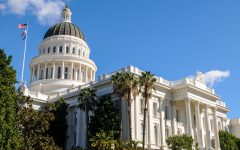
Great Seal of the State of California. (Photo: Kevin Sanders for California Globe)
Public Hearings Under the Administrative Procedure Act
The purpose of the hearing is to provide an evidentiary record permitting meaningful judicial review
By Chris Micheli, October 23, 2021 4:08 pm
As part of California’s Administrative Procedure Act (APA), the rulemaking bodies of the executive branch of state government must conduct a public hearing on a proposed regulation if requested by a member of the public. Pursuant to Government Code Section 11346.8, if a public hearing is held, both oral and written statements, arguments, or contentions must be permitted. However, the agency may impose reasonable time limitations on oral presentations.
This section of law also specifies that a public hearing must be held if, no later than 15 days prior to the close of the written comment period, an interested person or his or her duly authorized representative, submits in writing to the state agency, a request to hold a public hearing. If such a request is made by a member of the public, then a state agency must provide notice of the time, date, and place of the hearing by mailing the notice to every person who has filed a request for notice with the state agency.
State law also required the state agency to consider all relevant matter presented to it before adopting, amending, or repealing any regulation. The state agency has the authority, at any hearing, to administer oaths or affirmations. An agency may continue or postpone a hearing to the time and at the place as it determines. However, if a hearing is continued or postponed, the state agency is required to provide notice to the public as to when it will be resumed or rescheduled.
Finally, under this section of law, if a comment made at a public hearing raises a new issue concerning a proposed regulation and a member of the public requests additional time to respond to the new issue before the state agency takes final action, it is the intent of the Legislature that rulemaking agencies consider granting the request for additional time if, under the circumstances, granting the request is practical and does not unduly delay action on the regulation.
So, how have California courts viewed the public hearing requirements under the APA?
A hearing on a proposed regulation is “on the merits” and “meaningful” as required by the APA only if the interested public has timely received all available information that is relevant to the proposed regulations, accurate, and as complete as reasonably possible, regardless of whether large numbers of interested people were provided an opportunity to be heard. Sims v. Department of Corrections and Rehabilitation (2013) 216 Cal.App. 4th 1059
Although the right to a hearing in a quasi-legislative matter is not constitutionally compelled, both the mandate of the APA and the principles of fairness require a public hearing before a state agency may render its quasi-legislative decision. The purpose of the hearing, in part, is to provide an evidentiary record permitting meaningful judicial review. The hearing need not be “trial-like” in nature, nor is there any ineluctable right to present rebuttal evidence, or any requirements that the agency prepare findings in support of its quasi-legislative decision. Stauffer Chemical Company v. California State Air Resources Board (1982) 128 Cal.App. 3rd 789
Finally, where statutes prescribe hearing provisions for various individual agency proceedings, those provisions prevail over the more general provisions of the APA. AIDS Healthcare Foundation v. State Department of Health Care Services (2015) 241 Cal.App. 4th 1327
These public hearings are an important component of the rulemaking process. Interested parties should utilize these hearings to present their key arguments and advocacy materials to the state agency promulgating the regulation.
- Legislative Intent Does Not Equate to a Mandate - April 27, 2024
- Frequently Asked Questions about State Agency Ethics Training - April 26, 2024
- Frequently Asked Questions about When Elected Officials Take Office - April 25, 2024




